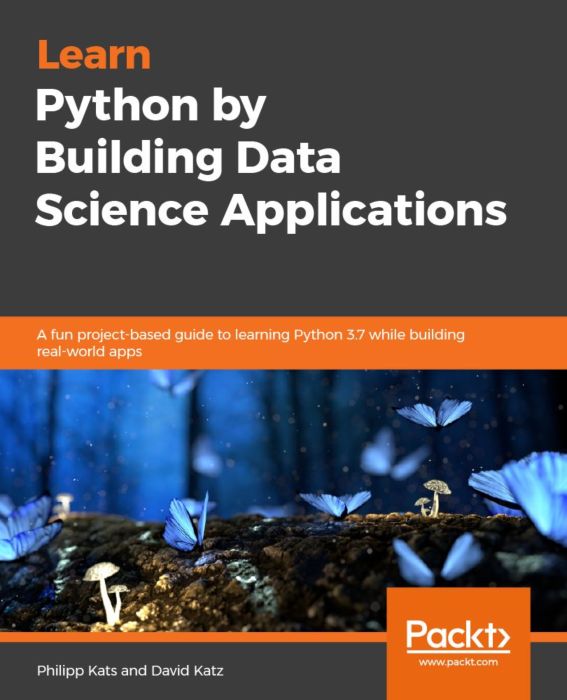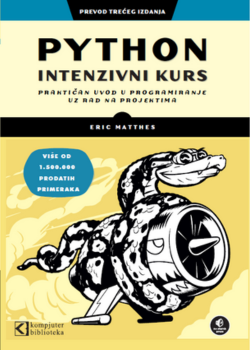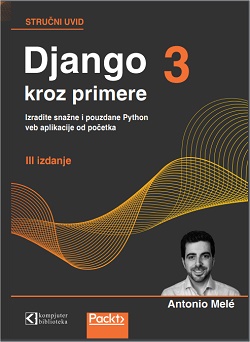
Autor: Philipp Kats, David Katz
Broj strana: 482
ISBN broj: 9781789535365
Izdavač:
PACKT PUBLISHING ![]()
Godina izdanja: 2019.
 |
 |
 |
 |
 |
||||
Python is the most widely used programming language for building data science applications. Complete with step-by-step instructions, this book contains easy-to-follow tutorials to help you learn Python and develop real-world data science projects. The “secret sauce” of the book is its curated list of topics and solutions, put together using a range of real-world projects, covering initial data collection, data analysis, and production. This Python book starts by taking you through the basics of programming, right from variables and data types to classes and functions. You’ll learn how to write idiomatic code and test and debug it, and discover how you can create packages or use the range of built-in ones. You’ll also be introduced to the extensive ecosystem of Python data science packages, including NumPy, Pandas, scikit-learn, Altair, and Datashader. Furthermore, you’ll be able to perform data analysis, train models, and interpret and communicate the results. Finally, you’ll get to grips with structuring and scheduling scripts using Luigi and sharing your machine learning models with the world as a microservice. By the end of the book, you’ll have learned not only how to implement Python in data science projects, but also how to maintain and design them to meet high programming standards.
Table of contents
1 Preparing the Workspace
Technical requirements
Installing Python
Downloading materials for running the code
Working with VS Code
Beginning with Jupyter
Pre-flight check
Summary
Questions
Further reading
2 First Steps in Coding - Variables and Data Types
Technical requirements
Assigning variables
Naming the variable
Understanding data types
Converting the data types
Exercise
Summary
Questions
Further reading
3 Functions
Technical requirements
Understanding a function
Defining the function
Refactoring the temperature conversion
Understanding anonymous (lambda) functions
Understanding recursion
Summary
Questions
Further reading
4 Data Structures
Technical requirements
What are data structures?
More data structures
Using generators
Useful functions to use with data structures
Comprehensions
Summary
Questions
Further reading
5 Loops and Other Compound Statements
Technical requirements
Understanding if, else, and elif statements
Running code many times with loops
Handling exceptions with try/except and try/finally
Understanding the with statements
Summary
Questions
Further reading
6 First Script – Geocoding with Web APIs
Technical requirements
Geocoding as a service
Learning about web APIs
Working with the Nominatim API
Caching with decorators
Reading and writing data
Moving code to a separate module
Collecting NYC Open Data from the Socrata service
Summary
Questions
Further reading
7 Scraping Data from the Web with Beautiful Soup 4
Technical requirements
When there is no API
Scraping WWII battles
Beyond Beautiful Soup
Summary
Questions
Further reading
8 Simulation with Classes and Inheritance
Technical requirements
Understanding classes
Using classes in simulation
Summary
Questions
Further reading
9 Shell, Git, Conda, and More – at Your Command
Technical requirements
Shell
Git
Conda
Make
Cookiecutter
Summary
Questions
10 Python for Data Applications
Technical requirements
Introducing Python for data science
Exploring NumPy
Beginning with pandas
Trying SciPy and scikit-learn
Understanding Jupyter
Summary
Questions
11 Data Cleaning and Manipulation
Technical requirements
Getting started with pandas
Working with real data
Getting to know regular expressions
Parsing locations
Time
Belligerents
Understanding casualties
Quality assurance
Writing the file
Summary
Questions
Further reading
12 Data Exploration and Visualization
Technical requirements
Exploring the dataset
Declarative visualization with vega and altair
Big data visualization with datashader
Summary
Questions
Further reading
13 Training a Machine Learning Model
Technical requirements
Understanding the basics of ML
Summary
Questions
Further reading
14 Improving Your Model – Pipelines and Experiments
Technical requirements
Understanding cross-validation
Exploring feature engineering
Optimizing the hyperparameters
Tracking your data and metrics with version control
Summary
Questions
Further reading
15 Packaging and Testing with Poetry and PyTest
Technical requirements
Building a package
A few ways to build your package
Testing the code so far
Automating the process with CI services
Generating documentation generation with sphinx
Installing a package in editable mode
Summary
Questions
Further reading
16 Data Pipelines with Luigi
Technical requirements
Introducing the ETL pipeline
Building our first task in Luigi
Understanding time-based tasks
Exploring the different output formats
Expanding Luigi with custom template classes
Summary
Questions
Further reading
17 Let's Build a Dashboard
Technical requirements
Building a dashboard – three types of dashboard
Understanding dynamic dashboards
Summary
Questions
Further reading
18 Serving Models with a RESTful API
Technical requirements
What is a RESTful API?
Building a basic API service
Building a web page
Speeding up with asynchronous calls
Deploying and testing your API loads with Locust
Summary
Questions
Further reading
19 Serverless API Using Chalice
Technical requirements
Understanding serverless
Getting started with Chalice
Setting up a simple model
Building a serverless API for an ML model
Building a serverless function as a data pipeline
Summary
Questions
Further reading
20 Best Practices and Python Performance
Technical requirements
Speeding up your Python code
Using best practices for coding in your project
Beyond this book – packages and technologies to look out for
Summary
Questions
Further reading
Budite prvi koji će ostaviti komentar.

Popust cena:
2280.00 rsd

Popust cena:
2280.00 rsd
© Sva prava pridržana, Kompjuter biblioteka, Beograd, Obalskih radnika 4a, Telefon: +381 11 252 0 272 |
||